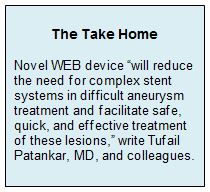Key Points:
- Two single-center studies report real-world use of percutaneous device in wide-necked intracranial bifurcation aneurysms
- Outcomes compare favorably to clipping and coiling
Good results that compare favorably with clipping and coiling have been reported by two European centers using a novel device for the treatment of wide-necked intracranial bifurcation aneurysms. Their findings were published online April 13, 2016, in the Journal of NeuroInterventional Surgery and April 15, 2016, in the Journal of Neurosurgery.
The Woven EndoBridge (WEB, Sequent Medical) is a novel, self-expanding intra-aneurysmal flow disruptor consisting of compliant braided nitinol mesh that can be deployed through a microcatheter into a saccular aneurysm. After deployment, it is retrievable and can be detached. The device is particularly useful for otherwise difficult to treat wide-necked intracranial bifurcation aneurysms.
German Experience
In the first study, Christin Clajus, MD, and colleagues from Helios General Hospital (Erfurt, Germany), collected data on their “real-world” experience with all iterations of the WEB device available in Europe for the treatment of ruptured (n = 47) and unruptured (n = 67) aneurysms that occurred in 108 patients treated between October 2010 and May 2015. Of these patients, 86 received clinical and angiographic follow-up at a mean of 13.4 months.
In all, 114 WEB devices were used, with 110 (96.5%) deployed correctly. Thromboembolic complications occurred in 11 (10%) of correctly deployed devices, resulting in a new permanent deficit in 1 patient.
Rerupture after WEB treatment was detected in 2 (4.3%) of the aneurysms, both in patients who had initially presented with subarachnoid hemorrhage. Angiographic follow-up revealed adequate occlusion in 68 of 90 aneurysms (75.6%), and 15 aneurysms required retreatment.
English Experience
In a smaller study led by Tufail Patankar, MD, investigators assessed the safety and complication rate associated with use of the WEB device among 22 patients who underwent 25 WEB treatments at Leeds Teaching Hospitals (Leeds, England). Of these procedures, 3 were performed on an acute basis, 1 was semiacute, and 21 were elective.
The investigators developed a novel 6-point scoring system called the Leeds WEB aneurysm occlusion scale to accurately assess the success of the procedure.
In this series, 22 (88%) of WEB deployments were successful. The remaining 3 (12%) were initially abandoned, but 1 of these patients subsequently underwent a successful second attempt. Of the 22 successful deployments, 4 (18%) resulted in complete occlusion, 10 (45%) in partial occlusion without aneurysm neck or remnant, 3 (14%) had a neck remnant, and 5 (23%) had an aneurysm remnant. Of the patients with an aneurysm remnant, 1 had a complete aneurysm occlusion at follow-up of 3 months or longer.
Radiological follow-up that took place at least 3 months after the procedure revealed residual aneurysms in 6 (27%) patients. One of these patients was admitted with hydrocephalus secondary to a recurrent aneurysm and later received a second WEB treatment with additional coiling. Another patient went from an mRS score of 0 to a score of 1 and had radiological evidence of a thromboembolic event. Two patients showed radiological evidence of a new thromboembolic event on follow-up MRI but had no symptoms.
An ‘Emerging’ Strategy
“The overall promising results in feasibility, safety, and effectiveness of the WEB reported in other studies is confirmed in our ‘real-world experience,’” write Dr. Clajus and colleagues. “Intra-aneurysmal flow disruptors represent an emerging endovascular treatment strategy for wide-necked bifurcation aneurysms, with the main advantages of not requiring permanent antiplatelet therapy and allowing the treatment of many of these aneurysms during a technically straightforward, efficient, single-step procedure.”
While other “techniques will continue to be necessary in a minority of cases,” they say, based on the combined results of the WEBCAST and French Observatory studies plus the current series, “we think that the WEB device can become the treatment of choice for many cerebral aneurysms.” They add that both occlusion rates at follow-up and the need for retreatment have “continually improved over the years, reflecting progressive improvements in the iterative versions of the WEB device as well as improved insight into case selection, optimal sizing, and delivery of the device.”
Similarly, Dr. Patankar and colleagues conclude: “Overall, the results appear to compare favorably with the results of coil embolization, with minimal risk of complication and morbidity and mortality. WEB treatment will reduce the need for complex stent systems in difficult aneurysm treatment and facilitate safe, quick, and effective treatment of these lesions. Long-term results and efficacy need to be assessed with an appropriately devised scoring system.”
Sources:
- Clajus C, Strasilla C, Fiebig T, et al. Initial and mid-term results from 108 consecutive patients with cerebral aneurysms treated with the WEB device. J NeuroInterv Surg. 2016;Epub ahead of print.
- Lawson A, Goddard T, Ross S, et al. Endovascular treatment of cerebral aneurysms using the Woven EndoBridge technique in a single center: preliminary results. J Neurosurg. 2016;Epub ahead of print.
Disclosures:
- Dr. Clajus reports receiving grants from Sequent Medical.
- Dr. Patankar reports being a proctor for WEB treatment.
